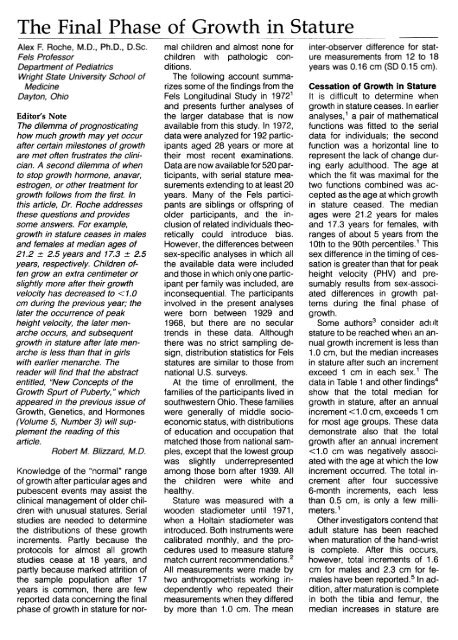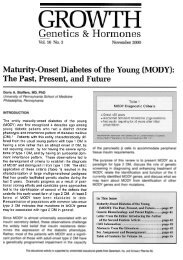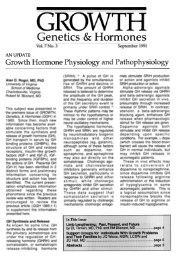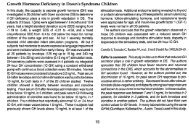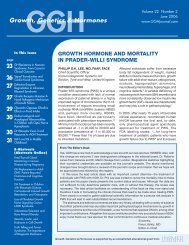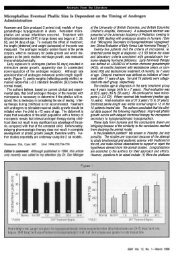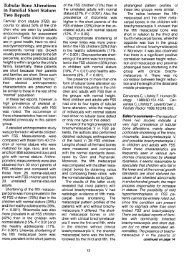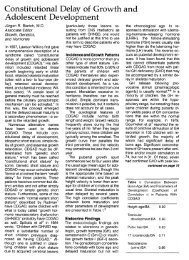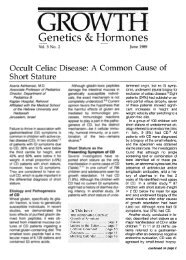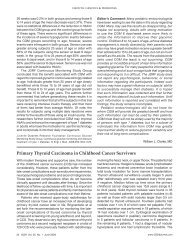The Final Phase of Growth in Stature - GGH Journal
The Final Phase of Growth in Stature - GGH Journal
The Final Phase of Growth in Stature - GGH Journal
Create successful ePaper yourself
Turn your PDF publications into a flip-book with our unique Google optimized e-Paper software.
Alex<br />
F. Roche, M.D., Ph.D., D.Sc.<br />
Fels Pr<strong>of</strong>essor<br />
Department <strong>of</strong> Pediatrics<br />
Wright State University School <strong>of</strong><br />
Medic<strong>in</strong>e<br />
Dayton, Ohio<br />
Editor's Note<br />
<strong>The</strong> dilemma <strong>of</strong> prognosticat<strong>in</strong>g<br />
how much growth may yet occur<br />
after certa<strong>in</strong> milestones <strong>of</strong> growth<br />
are met <strong>of</strong>ten frustrates the cl<strong>in</strong>ician.<br />
A second dilemma <strong>of</strong> when<br />
to stop growth hormone, anavar,<br />
estrogen, or other treatment for<br />
growth follows from the first. In<br />
this article, Dr. Roche addresses<br />
these questions and provides<br />
some answers. For example,<br />
growth <strong>in</strong> stature ceases <strong>in</strong> males<br />
and females at median ages <strong>of</strong><br />
21.2 :i: 2.5 years and 17.3 :i: 2.5<br />
years, respectively. Children <strong>of</strong>ten<br />
grow an extra centimeter or<br />
slightly more after their growth<br />
velocity has decreased to < 1. 0<br />
cm dur<strong>in</strong>g the previous year; the<br />
later the occurrence <strong>of</strong> peak<br />
height velocity, the later menarche<br />
occurs, and subsequent<br />
growth <strong>in</strong> stature after late menarche<br />
is less than that <strong>in</strong> girls<br />
with earlier menarche. <strong>The</strong><br />
reader will f<strong>in</strong>d that the abstract<br />
entitled, "New Concepts <strong>of</strong> the<br />
<strong>Growth</strong> Spurt <strong>of</strong> Puberty, " which<br />
appeared <strong>in</strong> the previous issue <strong>of</strong><br />
<strong>Growth</strong>, Genetics, and Hormones<br />
(Volume 5, Number 3) will supplement<br />
the read<strong>in</strong>g <strong>of</strong> this<br />
article.<br />
Robert M. Blizzard, M.D.<br />
Knowledge <strong>of</strong> the "normal" range<br />
<strong>of</strong> growth after particular ages and<br />
pubescent events may assist the<br />
cl<strong>in</strong>ical management <strong>of</strong> older children<br />
with unusual statures. Serial<br />
studies are needed to determ<strong>in</strong>ethe<br />
distributions <strong>of</strong> these growth<br />
<strong>in</strong>crements. Partly because the<br />
protocols for almost all growth<br />
studies cease at 18 years, and<br />
partly because marked attrition <strong>of</strong><br />
the sample population after 17<br />
years is common, there are few<br />
reported data concern<strong>in</strong>g the f<strong>in</strong>al<br />
phase <strong>of</strong> growth <strong>in</strong> stature for normal<br />
children and almost none for<br />
children with pathologic conditions.<br />
<strong>The</strong> follow<strong>in</strong>g account summarizes<br />
some <strong>of</strong> the f<strong>in</strong>d<strong>in</strong>gs from the<br />
Fels Longitud<strong>in</strong>al Study <strong>in</strong> 19721<br />
and presents further analyses <strong>of</strong><br />
the larger database that is now<br />
available from this study. In 1972,<br />
data were analyzed for 192 participants<br />
aged 28 years or more at<br />
their most recent exam<strong>in</strong>ations.<br />
Data are now available for 520 par-ticipants,<br />
<strong>in</strong>ter-observer difference for stature<br />
measurements from 12 to 18years<br />
was 0.16 cm (SO 0.15 cm).<br />
represent the lack <strong>of</strong> change dur<strong>in</strong>g<br />
early adulthood. <strong>The</strong> age at<br />
with serial stature measurements<br />
which the fit was maximal for the<br />
extend<strong>in</strong>g to at least 20years. two functions comb<strong>in</strong>ed was ac-<br />
Many <strong>of</strong> the Fels participants<br />
cepted as the age at which growth<br />
are sibl<strong>in</strong>gs or <strong>of</strong>fspr<strong>in</strong>g <strong>of</strong> <strong>in</strong> stature ceased. <strong>The</strong> median<br />
older participants, and the <strong>in</strong>clusion<br />
ages were 21.2 years for males<br />
<strong>of</strong> related <strong>in</strong>dividuals theo-<br />
and 17.3 years for females, with<br />
retically could <strong>in</strong>troduce bias. ranges <strong>of</strong> about 5 years from the<br />
However, the differences between<br />
sex-specific analyses <strong>in</strong> which all<br />
the available data were <strong>in</strong>cluded<br />
10th to the 90th percentiles.1 This<br />
sex difference <strong>in</strong> the tim<strong>in</strong>g <strong>of</strong> cessation<br />
is greater than that for peak<br />
and those <strong>in</strong> which only one participant<br />
height velocity (PHV) and pre-<br />
per family was <strong>in</strong>cluded, are sumably results from sex-associ-<br />
<strong>in</strong>consequential. <strong>The</strong> participants ated differences <strong>in</strong> growth patterns<br />
<strong>in</strong>volved <strong>in</strong> the present analyses<br />
dur<strong>in</strong>g the f<strong>in</strong>al phase <strong>of</strong><br />
were born between 1929 and growth.<br />
1968, but there are no secular Some authors3 consider adult<br />
trends <strong>in</strong> these data. Although<br />
there was no strict sampl<strong>in</strong>g design,<br />
distribution statistics for Fels<br />
statures are similar to those from<br />
national U.S. surveys.<br />
At the time <strong>of</strong> enrollment, the<br />
families <strong>of</strong> the participants lived <strong>in</strong><br />
southwestern Ohio. <strong>The</strong>se families<br />
were generally <strong>of</strong> middle socioeconomic<br />
status, with distributions<br />
<strong>of</strong> education and occupation that<br />
matched those from national samples,<br />
except that the lowest group<br />
was slightly underrepresented<br />
among those born after 1939. All<br />
the children were white and<br />
healthy.<br />
<strong>Stature</strong> was measured with a<br />
wooden stadiometer until 1971,<br />
when a Holta<strong>in</strong> stadiometer was<br />
<strong>in</strong>troduced. Both <strong>in</strong>struments were<br />
calibrated monthly, and the procedures<br />
used to measure stature<br />
match current recommendations.2<br />
All measurements were made by<br />
two anthropometrists work<strong>in</strong>g <strong>in</strong>dependently<br />
who repeated their<br />
measurements when they differed<br />
by more than 1.0 cm. <strong>The</strong> mean<br />
Cessation <strong>of</strong> <strong>Growth</strong> <strong>in</strong> <strong>Stature</strong><br />
It is difficult to determ<strong>in</strong>e when<br />
growth <strong>in</strong> stature ceases. In earlier<br />
analyses, 1 a pair <strong>of</strong> mathematical<br />
functions was fitted to the serial<br />
data for <strong>in</strong>dividuals; the second<br />
function was a horizontal l<strong>in</strong>e to<br />
stature to be reached when an annual<br />
growth <strong>in</strong>crement is less than<br />
1.0 cm, but the median <strong>in</strong>creases<br />
<strong>in</strong> stature after such an <strong>in</strong>crement<br />
exceed 1 cm <strong>in</strong> each sex.1 <strong>The</strong><br />
data <strong>in</strong> Table 1 and other f<strong>in</strong>d<strong>in</strong>gs4<br />
show that the total median for<br />
growth <strong>in</strong> stature, after an annual<br />
<strong>in</strong>crement
1.5 cm for males and 1.0 cm for<br />
females.1 <strong>The</strong> f<strong>in</strong>al phase <strong>of</strong><br />
growth <strong>in</strong> stature probably reflects<br />
elongation <strong>in</strong> the vertebral column.<br />
Increments after Peak Height<br />
Velocity (PHV) and Menarche<br />
<strong>The</strong> distributions <strong>of</strong> the total <strong>in</strong>crements<br />
after PHV are slightly larger<br />
for boys than for girls, with large<br />
differences between the 10th and<br />
90th percentile levels <strong>in</strong> each sex<br />
(Table 2). <strong>The</strong>se sex-associated<br />
differences are particularly large<br />
for the first year after PHV. <strong>The</strong><br />
annual <strong>in</strong>crements decrease rapidly<br />
after PHV, with almost as much<br />
growth <strong>in</strong> the first year as <strong>in</strong> the<br />
second to fifth years comb<strong>in</strong>ed.<br />
<strong>The</strong> data for annual <strong>in</strong>crements<br />
after PHV do not add up to the total<br />
<strong>in</strong>crements, because the groups<br />
for the annual <strong>in</strong>crements differ<br />
across <strong>in</strong>tervals. It is noteworthy<br />
that at least 10% <strong>of</strong> the boys and <strong>of</strong><br />
the girls had <strong>in</strong>crements greater<br />
than 1.0 cm even from 4 to 5 years<br />
after PHV.<br />
<strong>The</strong> median total stature <strong>in</strong>crement<br />
after menarche was 7.4 cm<br />
with a 10th to 90th percentile range<br />
from 4.3 to 10.6 cm. <strong>The</strong>se f<strong>in</strong>d<strong>in</strong>gs<br />
are <strong>in</strong> agreement with reports <strong>of</strong><br />
growth from menarche to the end<br />
<strong>of</strong> school attendance or to 18.25<br />
years.6.? <strong>The</strong> median <strong>in</strong>crements<br />
dur<strong>in</strong>g the first year after menarche<br />
exceeded the sum <strong>of</strong> the<br />
median annual <strong>in</strong>crements over<br />
the next 4 years.<br />
Relationships to the Tim<strong>in</strong>g <strong>of</strong><br />
PHV and Menarche<br />
<strong>The</strong> later the occurrence <strong>of</strong> PHV<br />
and menarche, the lesser the<br />
growth <strong>in</strong> stature after these<br />
events 1,4,8,9 (Figure), After PHV,<br />
there was considerably more<br />
growth <strong>in</strong> boys than <strong>in</strong> girls for<br />
groups matched <strong>in</strong> age at PHV, but<br />
the ranges from the 5th to the 95th<br />
percentiles and the slopes <strong>of</strong> the<br />
regressions were almost identical<br />
<strong>in</strong> each sex, <strong>The</strong> <strong>in</strong>crements <strong>in</strong><br />
boys from 14 to 17 years are also<br />
negatively related to stature at 14<br />
years,10<br />
Cl<strong>in</strong>ical Applications<br />
<strong>The</strong> preced<strong>in</strong>g data may serve as<br />
guides to the potential for growth <strong>in</strong><br />
stature, depend<strong>in</strong>g on the patient's<br />
maturational status. This <strong>in</strong>formation<br />
therefore may assist decisions<br />
about the <strong>in</strong>itiation or<br />
cessation <strong>of</strong> therapy. Such decisions<br />
will be <strong>in</strong>fluenced as well by<br />
the presence and nature <strong>of</strong> any<br />
pathological condition and by the<br />
attitude <strong>of</strong> the patient and the patient's<br />
family.<br />
More complex procedures utilize<br />
regression equations to pre-<br />
dict adult stature from childhood<br />
variables.3.11,12 <strong>The</strong>se require assessments<br />
<strong>of</strong> skeletal age and,therefor<br />
cannot be used after<br />
maturation <strong>of</strong> the hand-wrist is<br />
complete. Prediction methods<br />
based on regression are likely to<br />
be mislead<strong>in</strong>g when applied to<br />
children with chronic diseases that<br />
affect growth, with large overpredictions<br />
more likely than underpredictions.<br />
<strong>The</strong> Bayley-<br />
P<strong>in</strong>neau method13 is the best current<br />
procedure for predict<strong>in</strong>g the<br />
adult statures <strong>of</strong> children with diseases;<br />
but even with this method,<br />
the prediction errors are large.12<br />
<strong>The</strong> present data should be applicable<br />
to healthy children, <strong>in</strong>clud<strong>in</strong>g<br />
those with statures or maturational<br />
levels unusual for their<br />
chronological ages.<br />
In mak<strong>in</strong>g decisions regard<strong>in</strong>g<br />
the cessation <strong>of</strong> growth-promot<strong>in</strong>gtherapy,<br />
cl<strong>in</strong>icians may utilize the<br />
distributions <strong>of</strong> age at which<br />
growth <strong>in</strong> stature ceases. 1 This<br />
approach is limited <strong>in</strong> value, how-
Girls<br />
~ 35<br />
E!::.-<br />
GI<br />
~ 25-;<br />
cii<br />
.-15.c:i<br />
0<br />
c'.5 5<br />
Gi-;<br />
-J<br />
~ 35<br />
E!:..<br />
0)<br />
:J~<br />
...25<br />
C'ij<br />
c<br />
.-15.Coi<br />
0<br />
:"...",~<br />
~ 35<br />
E~<br />
Q)<br />
5 25<br />
"cQrn<br />
~<br />
c<br />
.-15.c~<br />
0~<br />
5<br />
~~~~<br />
GI<br />
c:; 5<br />
co co ~--~-~<br />
GI<br />
-5 T"I,,'~~' .,. -' -5 I ' , .,. ,j,.;,..' I', -' -5 -., ., ., ., ., ' ,'I<br />
10 11 12 13 14 15 16 17 10 11 12 13 14 15 16 17 10 11 12 13 14 15 16 17<br />
Age at PH V (years) Age at PH V (years) Age <strong>of</strong> Menarche (years)<br />
Figure Selected percentiles for the rema<strong>in</strong><strong>in</strong>g growth <strong>in</strong> stature (cm) after peak height velocity (PHV) and menarche <strong>in</strong><br />
relation to the ages at which these events occur. <strong>The</strong> <strong>in</strong>terrupted portion <strong>of</strong> the 5th percentile for growth <strong>in</strong> stature after<br />
menarche represents values that are less than zero. <strong>The</strong>se are unacceptable biologically but are found <strong>in</strong> actual data due<br />
to measurement errors.<br />
ever, because growth is very slow<br />
prior to cessation, and a decision<br />
made on this basis would commonly<br />
prolong therapy beyond t-Pie<br />
age at which it is effective. <strong>The</strong><br />
present data for expected growth<br />
after particular maturational<br />
events may <strong>of</strong>fer a more useful<br />
alternative for bas<strong>in</strong>g cl<strong>in</strong>ical<br />
judgments. In the absence <strong>of</strong> an<br />
effective stature prediction<br />
method for children with diseases,<br />
it is recommended that surveillance<br />
and treatment cont<strong>in</strong>ue until<br />
about 3 years after PHV or 2 years<br />
after menarche. <strong>The</strong> later these<br />
events occur, the shorter the follow<strong>in</strong>g<br />
period dur<strong>in</strong>g which treatment<br />
or surveillance should be<br />
cont<strong>in</strong>ued.<br />
Research Applications<br />
Another major potential application<br />
<strong>of</strong> these data is <strong>in</strong> study<br />
design. If the planned statistical<br />
analyses relate to differences <strong>in</strong><br />
stature <strong>in</strong>crements between experimental<br />
and control groups, the<br />
present data could assist a power<br />
analysis <strong>of</strong> the sample sizes required.<br />
<strong>The</strong>y could also <strong>in</strong>dicate<br />
the necessary duration <strong>of</strong> the<br />
study relative to age and maturity<br />
levels. If the study is to extend until<br />
growth <strong>in</strong> stature is complete <strong>in</strong><br />
90% <strong>of</strong> the group, data collection<br />
must cont<strong>in</strong>ue until about age 23.5<br />
years <strong>in</strong> males and 21.1 years <strong>in</strong><br />
females.1<br />
Conclusion<br />
<strong>The</strong> data discussed here describe<br />
late growth <strong>in</strong> normal children. Presumably,<br />
late growth occurs as<br />
well <strong>in</strong> children with chronic diseases,<br />
although the magnitude <strong>of</strong><br />
such changes is likely to be different.<br />
Application <strong>of</strong> these data<br />
therefore would require adjustment<br />
for the altered rate <strong>of</strong> growth<br />
produced by many diseases. <strong>The</strong>re<br />
is, however, <strong>in</strong>sufficient evidence<br />
on which to base these adjustments,<br />
and further studies are required<br />
to provide such support.<br />
References<br />
1. Roche AF, Davila GH. Pediatrics 1972;<br />
50:874-80.<br />
2. Lohman TG et ai, eds. Anthropometric<br />
Standardization Reference Manual.<br />
Human K<strong>in</strong>etic Publishers, Inc.,<br />
Champaign, Ill<strong>in</strong>ois, 1988.<br />
3. Tanner JM. Assessment <strong>of</strong> skeletal<br />
maturity and prediction <strong>of</strong> adult height<br />
(TW2 method). Academic Press,<br />
London, 1975.<br />
4. Lenko HL. Acta Paediatr Scand 1979;<br />
68:85-92.<br />
5. Garn SM et al. Am J Phys Anthropol<br />
1961 ;19:365-72.<br />
6. Fried RI, Smith EE. J Pediatr 1962;<br />
61:562-5.<br />
7. Roy MP et al. In: C.R. Xiiie Reunion des<br />
Equipes Chargees des Etudes sur la<br />
Croissance et Ie Developpement de<br />
l'Enfant Normal. Paris, 1974,39-41.<br />
8. Hulanicka 8, Kotlarz K. Ann Hum BioI<br />
1983;10:429-34.<br />
9. L<strong>in</strong>dgren G. Ann Hum BioI 1978; 5:<br />
253-67.<br />
10. Gallagher JR, Seltzer CC. Pediatrics<br />
1961 ;27:984.9.<br />
11. Roche AF et al. Monogr Paediatr<br />
1975;3:1-114.<br />
12. Roche AF. Acta Medica Auxologica<br />
1984; 16:5-28.<br />
13. BayleyN. P<strong>in</strong>neau SR. JPediatr1952;<br />
40:423-441.<br />
<strong>Growth</strong>, Genetics, and Hormones<br />
is published under an educational<br />
grant from Genentech, Inc. <strong>The</strong><br />
<strong>in</strong>formation <strong>in</strong> this publication reflects<br />
the views <strong>of</strong> the editors and<br />
does not necessarily reflect those<br />
<strong>of</strong> the sponsor or the publisher.<br />
Published by<br />
Healthcare Education Division<br />
McGraw-Hili Healthcare Group<br />
800 Second Avenue<br />
New York, NY 10017<br />
Copyright@ 1989.<br />
McGraw-Hili, Inc.<br />
All rights reserved.


